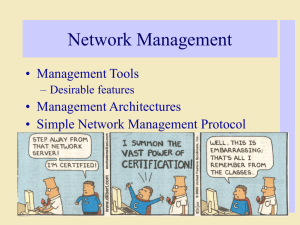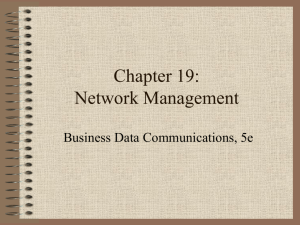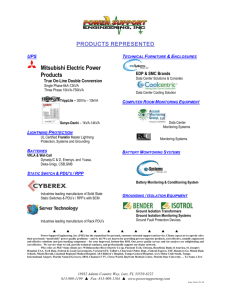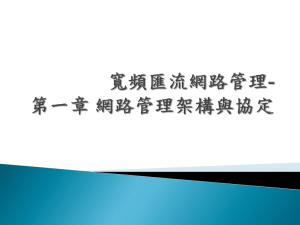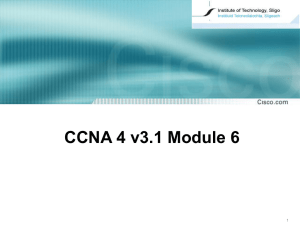PPT Version
advertisement
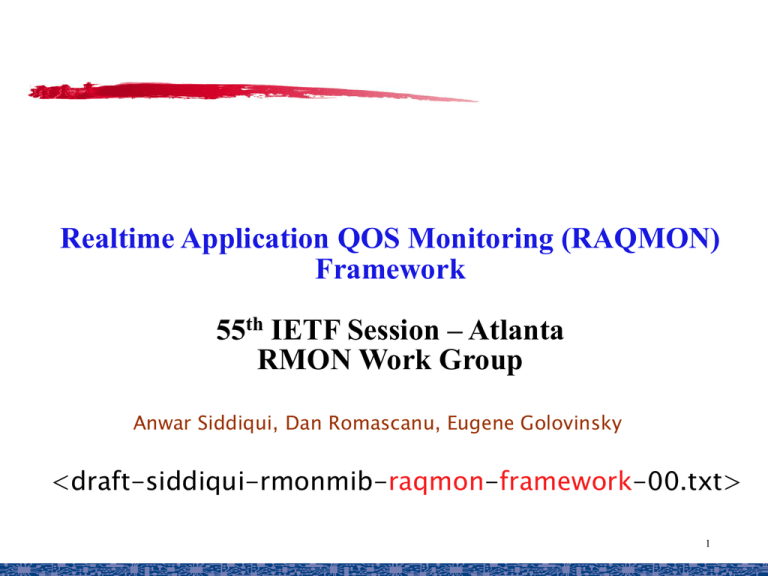
Realtime Application QOS Monitoring (RAQMON) Framework 55th IETF Session – Atlanta RMON Work Group Anwar Siddiqui, Dan Romascanu, Eugene Golovinsky <draft-siddiqui-rmonmib-raqmon-framework-00.txt> 1 Context Setting for the proposal MG PDA Application level priority (e.g. RSVP for S1, but no RSVP for S2) Applications Applications Streaming Media, Transaction, Bulk data transfer etc RTP / FTP/ HTTP RTP / FTP/ HTTP Various packet level priority ( TOS, DiffServ etc.) TCP/UDP IP IP MAC IEEE 802.3 PHYSICAL Domain 1 IP IP MAC 802.3 MAC 802.3 PHYSICAL PHYSICAL PHYSICAL Router IP End Points Router IP End Points IP Network TCP/UDP Domain 2 ……. Domain N MAC IEEE 802.3 Domain N+1 Multiple Equipment vendors, Multiple geographic locations, Multiple xSPs Control multiple Administrative and Provisioning domain 2 RAQMON Network Configuration Video/IP/IM/Voice Corporate Network Application Administrator Statistics Reported Voice over IP T e le ph one T e le ph one T e le ph one Rou ter Fa x Monitoring Applications via SNMP Laptop c omputer SNMP LAN/VPN INTRANET SNMP Regional Report Collector (Periodic Packets to populate MIB) IP Network Media Gateway Wireless Gateway SNMP SNMP Network / Application Service Provider PDA PDA Bluetooth Laptop c omputer 3 Scope of the Framework Out of Scope of Framework Protocol used to communicate Measurement Methodology Measurement Accuracy End Device RDS X End Device RDS RAQMON PDU over RTCP or SNMP RRC SNMP RAQMON MIB Scope of the Framework Existing Internet Protocol used to carry RAQMON PDU RAQMON SNMP MIB 4 RAQMON Architecture (Functional ) IP End Device Communication Network APPLICATION Context-sensitive Metrics (e.g.VoIP vs. Instant Messaging) Transport Network Condition Specific Metrics (e.g. Jitter) Network Policy Specific ( e.g. RSVP Failed, Diffsrv = EF) Device Sate Specific Metrics (e.g. CPU Usage) IP PSTN Cellular Optical RAQMON Data Source (RDS) Variable Metrics Parameters Updated using RAQMON PDU Transport Protocol Agnostic Network Alarm Manager (IP Address, port) RAQMON Report Collector (RRC) # 1 SNMP SNMP RAQMON MIB Management Application 5 Metrics “pushed” by the RDS to RRC - Data Source Name (DN) Receiver Name (RN) Data Source Address (DA) Receiver Address (RA) Data Source Device Port used Receiver Device Port used Session Setup Date/Time Session Setup delay Session duration Session Setup Status End-to-End Delay Inter Arrival Jitter Total number of Packets Received Total number of Packets Sent - Total number of Octets Received Total number of Octets Sent Cumulative Packet Loss Packet Loss in Fraction Source Payload Type Receiver Payload Type Source Layer 2 Priority Destination Layer 2 Priority Source Layer 3 Priority Destination Layer 3 Priority CPU utilization in Fraction Memory utilization in Fraction - Application Name/version This is a suggested matrix ….. Framework Accommodates addition of new parameters to the list6 ….. What is not proposed in RAQMON Framework! Creation/Extension/Modification of any existing protocol in order to support RAQMON PDU is out of scope of the RAQMON charter proposal Methodology to measure any of the QOS parameters defined in the RAQMON Framework is out of scope for this proposal. – Measurement algorithms are left upon the implementers and equipment vendors to choose. – Consistent with other RMON WG work items like APM, TPM etc. 7 Overall RAQMON I-D Status RAQMON idea was first presented at 51st IETF session in RMON WG – There seemed interest in 51st IETF session by the RMON community RAQMON I-D was made available for 52nd IETF – draft-siddiqui-rmonmib-raqmon-mib-00.txt Discussions around RAQMON I-D have happened – within the RMON mailing list during 52nd and 53rd IETF – out of band interest/comments from various vendors for participation Official RAQMON charter went out after 54th IETF – 3 drafts were called out in the charter – RAQMON Framework, RAQMON PDU and RAQMON MIB 8 RAQMON Protocol Data Unit (PDU) 55th IETF Session – Atlanta RMON Work Group Anwar Siddiqui, Dan Romascanu, Eugene Golovinsky <draft-siddiqui-rmonmib-raqmon-pdu-00.txt> 9 RAQMON PDU Overview A set of RAQMON Application level PDUs to have “common formats” for reporting statistics – RAQMON PDUs will be transported over existing protocols – – Minimal (preferably No) setup transaction to tell the collector which metrics the data source will be sending later on. RAQMON PDUs can be lossy – RDS reports what “IT” feels to be appropriate for the “application context” RRC consumes what “IT” feels to be appropriate for the “application context” RDS RRC communication should be stateless – RTCP (using RTCP APP Packets) SNMP (using SNMP INFORM) RDS and RRC are Peer-to-Peer entities – – Between a RAQMON Data Source (RDS) and a RAQMON Report Collector (RRC). Complementary to IPFIX charter RAQMON PDUs should be extensible for future – To add additional matrices 10 RAQMON PDU Types BASIC PDU – Basic PDUs are TLV pair – Draft provides a list of initial matrix (i.e. not meant to be exhaustive) – Matrix parameters are selected by the apps – Compound sessions can be reported as multiple sub-sessions – End devices control the rate of reporting APP PDU – Can be extended to add new parameters not spelled out in initial draft 11 RAQMON PDU over RTCP RAQMON PDUs inside RTCP APP Packets Different Ports will be IANA registered for RAQMON PDUs over RTCP Version & subtype PT=204 Length RTCP APP Packet SSRC/CSRC Name=RAQMON (ascii) RAQMON PDU RAQMON specific and IANA Registered 12 RTCP Pros and Cons PROS Using a well-known protocol. Very light weight Privacy and authentication are covered by RTP/RTCP No acknowledgement required CONS RRC is burdened by RTCP RRC have to be RTCP sink! – Need to understand atleast RTCP APP Packets 13 RAQMON PDU over SNMP RDSs will not be required to respond to SNMP requests – Keep the RDS design simple. The RDS “MAY” ignore the SNMP Inform Responses, or, if better – Requires retransmission Inform PDU RAQMON information is mapped to an SNMP Inform PDU in 2 ways. – – Mapping RAQMON data items to MIB variables (i.e. uses NOTIFICATION-TYPE macro) Encoding RAQMON PDU format within a small set of MIB items. 14 SNMP Pros & Cons PROS Using a well-known protocol. Easy integration with RMON Framework Privacy and authentication are covered by SNMPv3 RRC can use an SNMP manager implementation to process Informs. CONS Overhead SNMP puts on low-powered RDSs! – BER encoding on a PDA or a pager or in an IP Phone Proposed Solution: To alleviate this, possibility of encoding INFORM PDUs using UTF-8 should be studied further. However this would require – – a RAQMON PDU specific code in the RRC, and a new IANA UDP port Acknowledgements from RRCs to RDSs can create bottleneck Session centric RDS design Sending ACKs also wastes network bandwidth. 15 Backgrounder 16 Relationship to current work in various WGs Rapmon Framework correlates “per transactions statistics” to “performance of a particular transaction” (e.g. call setup call’s media stream performance) Proposed Rapmon Framework conforms to APM and TPM completely. Rapmon work is complementary to the work that’s going on in ippm WG. This proposal conforms to ippm WG’s recommendations fully. Proposed Rapmon Framework is complimentary to current work that is going on in the areas of synthetic source. 17
